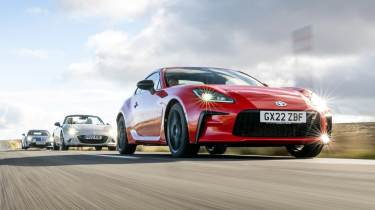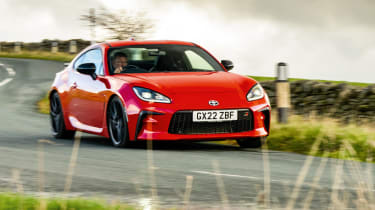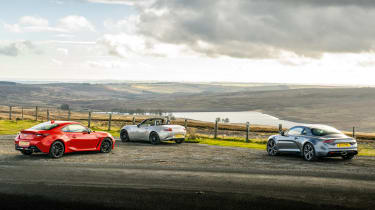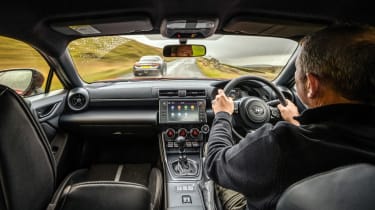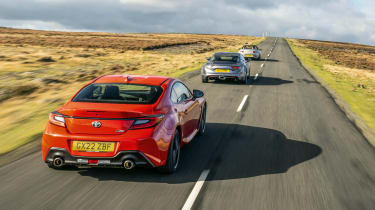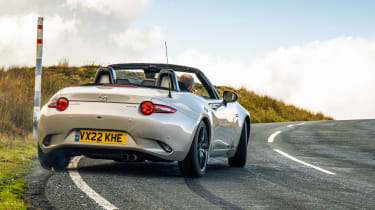Toyota GR86 v Mazda MX-5 v Alpine A110 GT
Toyota has revamped its entry-level sports coupe to create the GR86, but how does it stack up against Mazda’s evergreen MX-5 and Alpine’s formidable A110 when it comes to delivering pure driving fun?
Before you conclude that we’ve lost the plot by lining up a near-60-grand mid-engined sports car from France with a pair of front-engined wannabes from Japan that cost half as much and aren’t anywhere near as quick, consider this: when Toyota launched the GT86 in 2012 it all but redefined the way we think about so-called driver’s cars. At a stroke, the rear-drive but not very grippy, not especially potent GT86 underlined the notion that speed in itself is not the holy grail when it comes to pure driver enjoyment, and we’ve celebrated its existence ever since.
Which is why the prospect of a faster, meaner, leaner GT86 can’t help but grab our attention ten years and one global pandemic later. It also explains why the traditional parameters of price, power, size and specification tend to get thrown out of the window when it comes to choosing the right opposition to pit against the new 2.4-litre, 231bhp, £29,995 GR86.
> Where have all the affordable driver's cars gone?
In any case, a good sports car is a good sports car, no matter how much it might cost or how little power it may have. So bring it on, as they say, because if our initial impressions of the GR86 are accurate, this is a car that’s quite happy to take on all comers, in all shapes and sizes, and at almost any price. Hence the reason we’ve lined it up beside one of our favourite mid-engined sports cars this side of £100k, the breathtakingly lovely Alpine A110 GT, as well as the somewhat more predictable Mazda MX-5 2.0 GT Sport Tech, a textbook front-engined, rear-drive, open-top two-seater that costs just £1865 more than the Toyota.
And they are all, without question, sports cars.
But which one nails the brief most accurately, which is the best sports car here, and is it honestly credible to be comparing the Alpine with a Mazda and a Toyota that cost the same as the A110 combined? The answers will come with miles, as ever, this time across the granular and often unpredictable roads of Northumberland, but one thing’s certain right away: no matter how disparate these three may appear on paper, in reality they square up to one another peculiarly well on the road. In simple terms they represent three logical stages along the route to driving nirvana, and in the end that’s really the only quality a true sports car needs to deliver: pure, undiluted driving entertainment.
The $64,000 (or £60,000) question is: do you need to spend twice as much money to attain it in the Alpine or is it available for half as much money in the Mazda and Toyota? Or to put it another way, is the Alpine twice as much car as the others, and is the holiest of holies actually more attainable in the cheaper Japanese cars because their limits are that much more accessible?
The GR86 may well be the new kid on the block but the concept behind it is nothing new. To be fair it’s merely the all-new version of an already well-established car, yet somewhat tragically it is already no longer on sale. Yup, all of the UK’s 430 or so allocation of GR86s has now gone, and according to Toyota it won’t be building any more any time soon because pedestrian impact laws mean the front end would need to be completely re-engineered to make it comply, and that’s not and never will be in the business case for the GR86. So we’ll lose what appears to be a brilliant car before we’ve even got to know it properly, although if you’re smart enough to have nabbed one for yourself, it could prove highly lucrative in the longer term.
No matter, because in the here and now the GR86 exists and has been taken to a whole new level of ability thanks to a range of upgrades, most of which would appear to be extraordinarily well judged. The big news is the adoption of a 2.4-litre version of the GT86’s original 2-litre flat-four engine that produces another 34bhp and 33lb ft, taking it to 231bhp and 184lb ft. Combined with a snappier gearshift this has slashed the 0-62mph claim by over a second to 6.3sec, although the top speed stays the same at 140mph.
The centre of gravity has also been lowered a touch, the wheelbase lengthened by 5mm, and this time the tyres aren’t deliberately rubbish Prius cast-offs but are instead proper Michelin Pilot Sport 4s. The adoption of these gives perhaps the biggest clue to the GR86’s more committed personality. It’s more serious in its intentions this time and has become a sports car for people who actually know what they’re doing, rather than one for those who are still learning their craft. Its limits are higher, its performance is stronger and its focus is centred on getting down the road at a much more serious lick.
Enter the MX-5, which continues to occupy the ground just beneath, where the limits are a touch lower, the dynamic appeal less potent perhaps, but where the fun factor is every bit as strong on the surface, possibly because it’s available at lower speeds and for more of the time, to more people.
Despite the GR86’s admirable diet – it weighs just 1276kg – the MX-5 is still the lighter of the two Japanese cars by some 224kg, Mazda claiming a kerb weight of just 1052kg for its roadster. It’s joined by 181bhp and 151lb ft from a 2-litre in-line four, and like the Toyota there’s a six-speed manual gearbox and a mechanical limited-slip diff. Zero to 62mph takes a claimed 6.5sec and the top speed is 136mph, putting it broadly on a par with the GR86 on paper, although in reality it lacks torque beside the Toyota and is nowhere near as energetic in the mid-range.
The Alpine A110 GT, on the other hand, is pretty much the polar opposite of the two front-engined Japanese cars. Its 1.8-litre engine doesn’t just sit behind the occupants rather than in front, with a dual-clutch paddleshift gearbox rather than a traditional manual, it’s also turbocharged and produces much more power and torque – 296bhp and 251lb ft. So although at 1119kg in GT trim it weighs a touch more than the MX-5, the A110 is still in a different league when it comes to pure performance, zero to 62mph taking just 4.2sec and with a top speed limited to 155mph. Untethered, it would do a fair bit more than this, you suspect.
Yet despite their wildly differing levels of outright performance, the A110 doesn’t disappear over the horizon at the first sight of a great driving road, of which there are many in Northumberland. Nor does it take you to a quantifiably deeper level of driver indulgence, not to begin with at any rate. Instead it’s just different. Its steering is lighter and more delicate in its weighting because it doesn’t have the heft of an engine to deal with over its front axle, but it’s not ‘better’ than the GR86’s steering (which is delicious) or any more alert than the MX-5’s. Which is a theme that continues to develop the more miles we do in these cars. They all do things differently from one another but it’s hard, sometimes impossible, to decide which one you actually prefer driving – because they each have their own individual methods of entertainment.
It does make you wonder at times if the Alpine – which doesn’t particularly feel a class up from the Japanese cars, despite its overtly mid-engined driving position and gentlemen’s club brown leather trim – could ever really be worth double what the other two cost, both of them simpler inside but also extremely well built. Especially when you alight from any of them at the end of a nose-to-tail cross-country journey, extolling the virtues of whichever one you happen to have been driving last. Point is, all three are perfectly nice cars just to be in, without having particularly gorgeous or well-appointed interiors, and they’re all terrific entertainers, although I do have a favourite, more on which in a bit.
In the meantime, let’s talk gearboxes, specifically about whether a dual-clutch can ever be a match for the snickety-snick precision of the manuals in the Mazda and Toyota. Personally I think it can, because I’m a big fan of dual-clutches if done properly, and in the A110 it works a treat, especially if you select Sport mode, which sharpens up the throttle and exhaust maps as well as the gearshift speeds. Yet I’m prepared to admit that, in the right circumstances, the joy of exacting a perfect heel-and-toe downshift in a car like the GR86 – whose six-speed manual is just miles better than it used to be in the GT86 – does take some beating.
The gearbox itself, indeed the entire drivetrain, does need to be downright brilliant if a manual is ever going to get anywhere near a good dual-clutch in terms of shift speed and quality, though, which means the weighting and precision of the shift mechanism and the syncing (and weight) of the clutch all need to be perfectly aligned with one another, otherwise you’d be much better off with a decent DCT. But in both these cases, they are. Between them, the GR86 and MX-5 have possibly the two best manual gearboxes – and entire drivetrains, in fact – that money can buy right now. So yes, they are both probably more satisfying to change gear in than the A110, although I’d still argue that you can swap cogs faster and more efficiently in the Alpine, even if there’s less pleasure to be derived from doing so.
Same with the way they steer. The A110’s helm is lighter, sharper in its initial response and arguably more responsive than the GR86’s just off-centre, while the MX-5’s steering has a lot more going on at the rim at all times, partly because there’s simply more going on in the Mazda. But that’s due mainly to the MX-5’s suspension being so much softer than the others, which allows its body to move around to a greater degree and more obviously so over the kind of yumps and humps that come at you on roads such as these, all of which manifests itself at the steering wheel. Which is why simply guiding the MX-5 through a series of turns that would seem quite innocuous in the other two feels like a fairly monumental achievement in the Mazda. But that’s what you get in the UK, so that’s what you have to deal with, and it’s interesting to note just how differently these cars steer over the same roads.
The GR86’s helm is the sweetest of the three by a fair margin overall, because where the MX-5 relays almost too much of what the suspension is having to deal with via its rim and the A110 is a touch too-cool-for-school in its mild aloofness in response over the same roads, the GR86 nails the perfect compromise between these extremes. Its steering provides your hands, and therefore your brain, with just enough information about what’s going on at the front tyres, but no more than is necessary.
Sounds cheesy, but you really can feel every grain of whatever surface the GR’s front tyres encounter as you guide it along roads such as these. Every nuance in the road’s camber and every change in tarmac quality is directly relayed to your fingertips, without there ever being any unwanted kickback through the rim. It gives you massive confidence in the car, not just in what the front end is up to but the rear as well, which feels rooted no matter how hard you push things. You can even begin to feel slightly invincible in the GR86, as if it will simply never let go, no matter how hard you try, which is always a dangerous but telling observation.
If you then add in the GR’s beautifully judged damping and its lovely brake feel, plus the very obvious extra level of thrust from its brawnier 2.4-litre engine, it makes for one heck of a strong cocktail. Not to mention a faster, more capable but also more entertaining car than the GT86 ever was. No question, the GR86 has become a quick car in its own right, no excuses, and although by definition a great sports car doesn’t need to be a mind-alteringly rapid one, the GR’s more intense cross-country pace is a game-changer all the same – not least because it allows it to keep up quite easily with a car like the A110 GT. I’m not sure the old GT86 could have managed that, no matter how hard you might have tried.
Having said that, there’s something deeply engaging about attempting – and sometimes failing – to keep up with the other two cars when driving the MX-5 in convoy across country. At one point I found myself in the Mazda with the hood down, wipers on, watching the GR86 get smaller in the windscreen as the A110 appeared larger and more impatient in the rear-view mirror. And for approximately ten minutes I drove it just about as fast as I dared, and still the Toyota continued to edge away.
But when we stopped and compared notes, I was the only one giggling with adrenaline, and the drivers of the other two cars couldn’t really understand why. They’d been driving hard, for sure, but nowhere near the ragged edge, which is where I’d been operating for much of the time. So despite the Mazda’s waywardly soft read end, its woeful absence of torque beside the GR (let alone the A110) and its hang-on-if-you-can handling and steering, I found it hugely entertaining. At which point a thought occurred: when was the last time I drove a car this hard, for this long, on a public road without it being technically illegal? Maybe in 1990-something, and probably in a 2CV.
Of course, the 181bhp MX-5 GT Sport Tech is nowhere near as amusingly incompetent as the Citroën, which was good at carrying eggs across a field but, dynamically, not much else. In isolation the Mazda is a great little car. But as with everything in life, relativity is what counts, and in this company its dynamic shortcomings are obvious but weirdly endearing. They make it extremely easy to enjoy driving, even in this elevated company. So it’s possible to make a case for it being the best value here because, on a basic level, you really do have more fun in it, more of the time.
But as much fun as you can have in the A110 GT ultimately? Really? I’m not so sure. Actually no, I am sure, and the answer is no. Because, like the GR86 only more so, the A110 can do things and take you to places emotionally that, for all its charms, the sometimes wayward Mazda can never replicate. Even at eight tenths the A110 GT rocks. At nine and a half tenths it does things to your heart and mind that the MX-5 hasn’t even thought of.
Some of this is down purely to the extra level of performance it has, no question, but the delicacy and balance of its mid-engined chassis and its fine steering are also key elements to its appeal, and neither of these require any great speed to appreciate. The A110’s soothingly fluid ride will blow you away at 15mph, almost as much as its ability to flatten out a road or turn in so incisively to a corner at four times that speed. In a way its effortless ability to simply deal with what’s going on beneath your backside is what defines the A110, yet it’s still a car that percolates with feel through its steering, seats, pedals and tyres.
In the end it’s just a very, very lovely thing to drive. But it’s not the best sports car here, and by that I don’t mean ‘not the best sports car for the money’. I mean not the best sports car, full stop. Because that car is the GR86.
It may have taken a step backwards visually; most of us reckon the original GT86 is a prettier, sexier looking car overall. And we’ve already mentioned the supply issues. But ignoring all of this, the GR86 is quite simply one of the greatest sports cars of the current era. Then again, it needs to be to beat the Alpine A110 GT.
Specs
| Toyota GR86 | Mazda MX-5 2.0 GT Sport Tech | Alpine A110 GT | |
| Engine | Flat 4-cyl, 2387cc | In-line 4-cyl, 1998cc | In-line 4-cyl, 1798cc, turbocharged |
| Power | 231bhp @ 7000rpm | 181bhp @ 7000rpm | 296bhp @ 6300rpm |
| Torque | 184lb ft @ 3700rpm | 151lb ft @ 4000rpm | 251lb ft @ 2400-6000rpm |
| Weight | 1276kg | 1052kg | 1119kg |
| Power-to-weight | 183bhp/ton | 175bhp/ton | 269bhp/ton |
| 0-62mph | 6.3sec | 6.5sec | 4.2sec |
| Top speed | 140mph | 136mph | 155mph (limited) |
| Basic price | £29,995 | £31,860 | £58,100 |
This story was first featured in evo issue 304.
